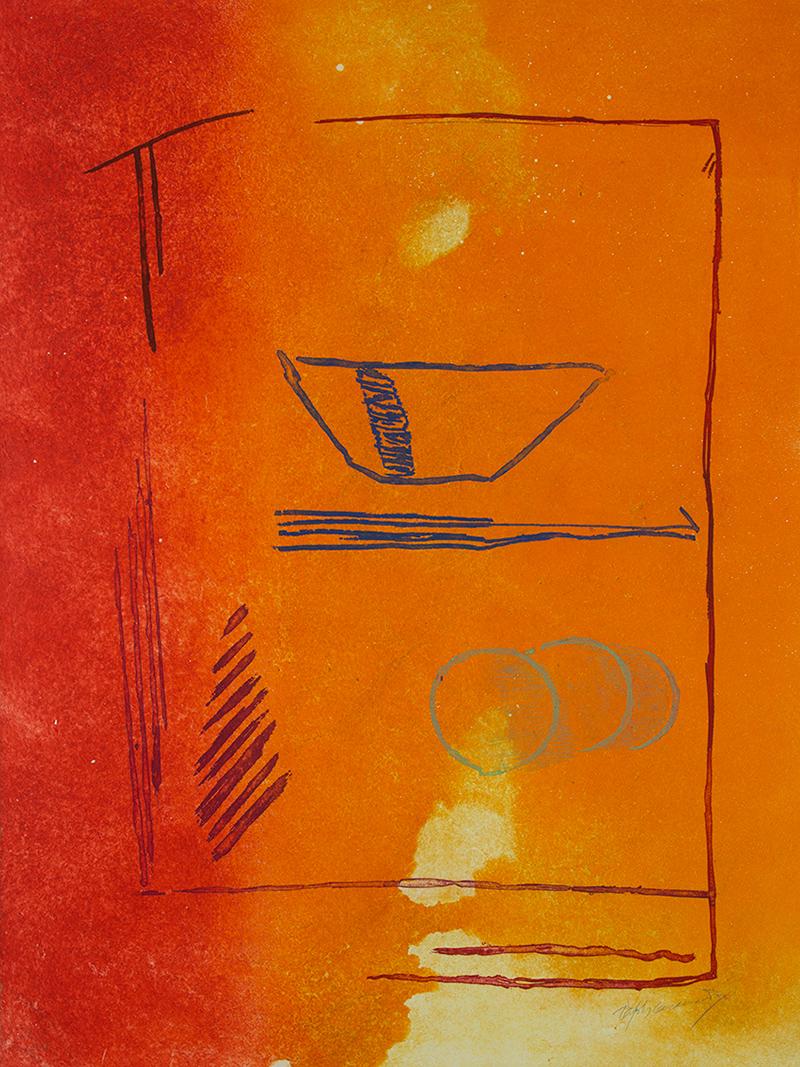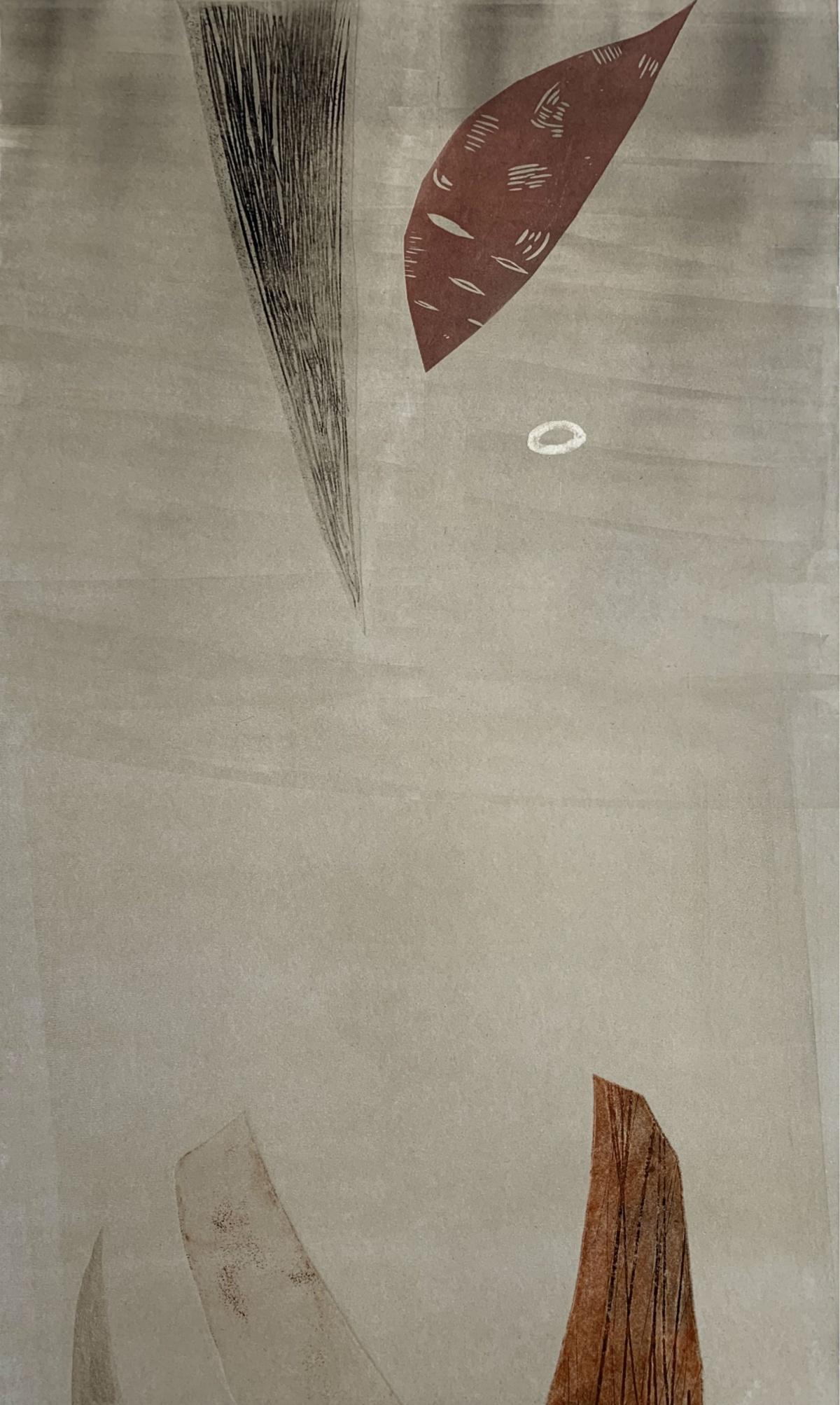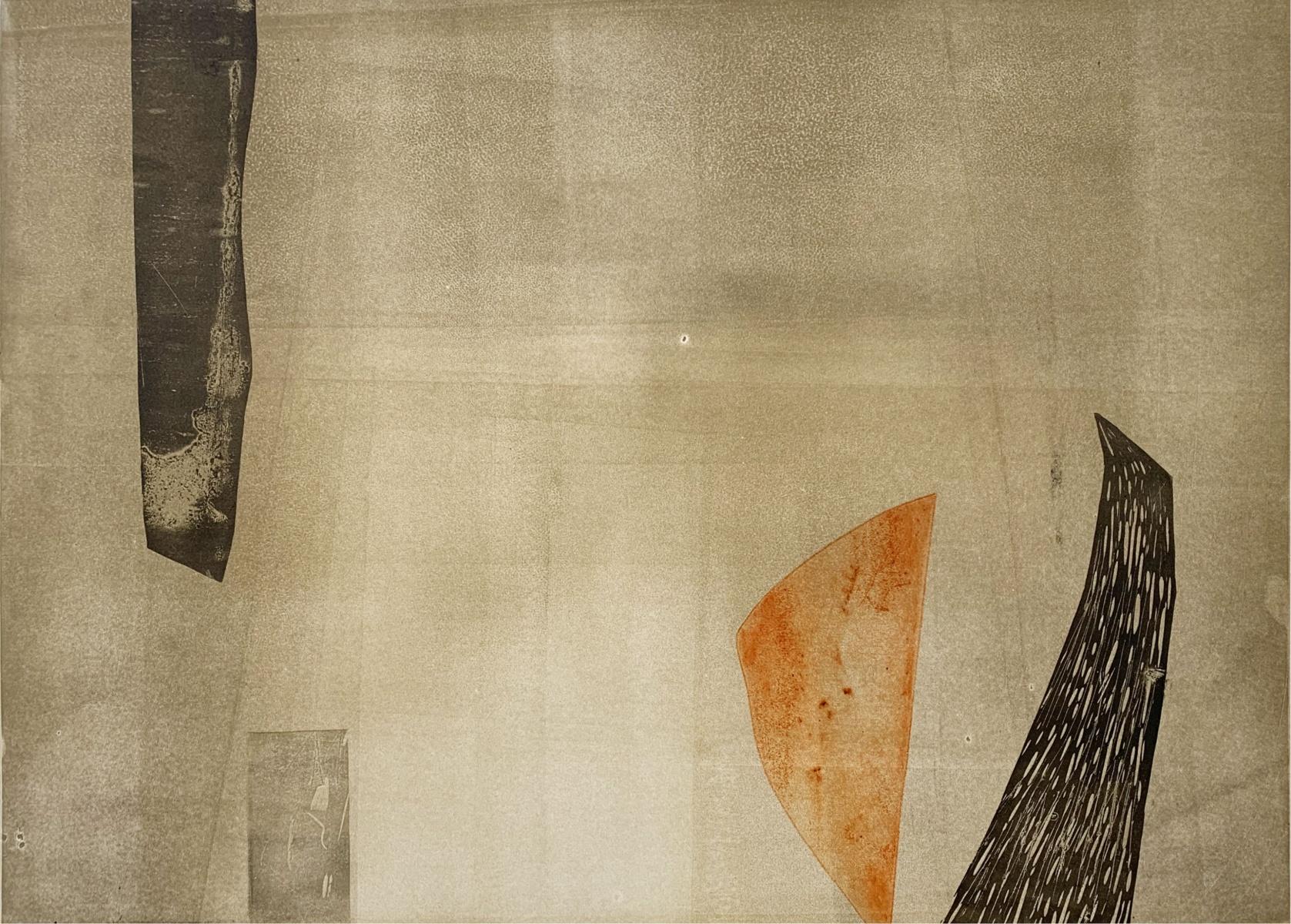Joan MiróDemi-Mondaine a sa fenetre (Small Socialite at Her Window)1975
1975
About the Item
- Creator:Joan Miró (1893 - 1983, Catalan)
- Creation Year:1975
- Dimensions:Height: 36 in (91.44 cm)Width: 24.75 in (62.87 cm)
- Medium:
- Movement & Style:
- Period:
- Condition:
- Gallery Location:Missouri, MO
- Reference Number:1stDibs: LU747311356502
Joan Miró
With his wide-ranging oeuvre, comprising strikingly original paintings, prints, ceramics, sculptures, metal engravings and murals, Catalan modernist Joan Miró was a critical force in moving 20th-century art toward complete abstraction. Although often considered an early Surrealist because of his nonobjective imagery and evocation of the subconscious, he defies neat categorization.
Miró’s identity is largely rooted in the city of his birth: Barcelona. To this day, a number of his public artworks can be found there, including the 72-foot-tall statue Dona i Ocell (Woman and Bird), 1983. Female and avian forms, along with bright colors and the theme of Catalan pride, are recurring elements in his work.
The radical visual world Miró created with his expressive lines, signature symbols and biomorphic shapes influenced such American Abstract Expressionists as Jackson Pollock and Color Field painters like Mark Rothko and Barnett Newman.
Mirò continued to work and experiment until his death at the age of 90 in 1983. Five years before that, he was quoted saying, “I painted these paintings in a frenzy, with real violence so that people will know that I am alive, that I’m breathing, that I still have a few more places to go. I’m heading in new directions.”
Find a collection of original Joan Miró art on 1stDibs.
- ShippingRetrieving quote...Ships From: Missouri, MO
- Return PolicyA return for this item may be initiated within 2 days of delivery.
- Gaudi XX, (D. 1079)By Joan MiróLocated in Missouri, MOGaudi XX, (D. 1079), 1979 By. Joan Miro Signed Lower Right Edition 41/50 Lower Left Unframed: 37.5" x 30.75" Framed: 46.5" x 39" Joan Miro was born in Barcelona, Spain on April 20, 1893, the son of a watchmaker. From 1912 he studied at the Barcelona Ecole des Beaux-Arts and the Academie Gali. In the first quarter of the 20th century, Barcelona was a cosmopolitan, intellectual city with a craving for the new in...Category
20th Century Abstract Abstract Prints
MaterialsPaper, Etching, Aquatint
- Senza Titolo 10 (Lynton G.68)By Victor PasmoreLocated in Missouri, MOSenza Titolo 10 (Lynton G.68), 1989 By. Victor Pasmore (1908-1998) Etching and Aquatint Signed Bottom Right Edition 47/90 Bottom Left Site Size: approx. 30 x 80" Framed Size: approx...Category
20th Century Abstract Abstract Prints
MaterialsEtching, Aquatint
- WALL STREET JOURNAL, DINNER TRIANGLESBy James RosenquistLocated in Missouri, MOFramed Size: approx. 27 x 44 inches James Rosenquist (1933-2017) "WALL STREET JOURNAL, DINNER TRIANGLES" 1977 Etching and Aquatint on Paper Signed...Category
1970s Modern Abstract Prints
MaterialsEtching, Aquatint
- BethsabeeBy Joan MiróLocated in Missouri, MOJoan Miro “Bethsabee” 1972 Etching and Aquatint in Colors on Wove Paper Hand-Signed by the Artist in Pencil Lower Right Numbered in Pencil “5/50” Lower Left Maeght editeur Pairs Printing: Morsang, Paris Sheet Size: 36 x 24 3/4 inches Framed Size: approx 41 x 39 inches Catalogue Raisonne: Miro Engravings Vol. 2 (1961-1973), Pg. 197, #556 Joan Miro was born in Barcelona, Spain on April 20, 1893, the son of a watchmaker. From 1912 he studied at the Barcelona Ecole des Beaux-Arts and the Academie Gali. In the first quarter of the 20th century, Barcelona was a cosmopolitan, intellectual city with a craving for the new in art...Category
1970s Modern Abstract Prints
MaterialsEtching, Aquatint
- Abstract (Edition 24/75)By Bram Van VeldeLocated in Missouri, MOAbstract (Edition 24/75) By Bram van Velde (1895-1981) Signed and Numbered Bottom Center Without Frame: 37" x 24" With Frame: 37.75" x 24.75" Bram (Abraham Gerardus) van Velde was a Dutch painter known for an intensely colored and geometric semi-representational painting style related to Tachisme*, and Lyrical Abstraction*. He is often seen as member of the School of Paris* but his work resides somewhere between expressionism* and surrealism*, and evolved in the 1960s into an expressive abstract art. His paintings from the 1950s are similar to the contemporary work of Matisse, Picasso and the abstract expressionist Adolph Gottlieb. He was championed by a number of French-speaking writers, including Samuel Beckett and the poet André du...Category
20th Century Abstract Abstract Prints
MaterialsLithograph
- Observador de PajarosBy Rufino TamayoLocated in Missouri, MO"Observador de Pajaros" 1950 By. Rufino Tamayo (Mexican, 1899-1991) Edition 83/210 Lower Right Signed Lower Left Unframed: 15.5" x 22.5" Framed: 21.75" x 28.25" Rufino Tamayo (August 26, 1899- June 24, 1991) A native of Oaxaca in Southern Mexico, Rufino Tamayo's father was a shoemaker, and his mother a seamstress. Some accounts state that he was descended from Zapotec Indians, but he was actually 'mestizo' - of mixed indigenous/European ancestry. (Santa Barbara Museum of Art). He began painting at age 11. Orphaned at the age of 12, Tamayo moved to Mexico City, where he was raised by his maternal aunt who owned a wholesale fruit business. In 1917, he entered the San Carlos Academy of Fine Arts, but left soon after to pursue independent study. Four years later, Tamayo was appointed the head designer of the department of ethnographic drawings at the National Museum of Archaeology in Mexico City. There he was surrounded by pre-Colombian objects, an aesthetic inspiration that would play a pivotal role in his life. In his own work, Tamayo integrated the forms and tones of pre-Columbian ceramics into his early still lives and portraits of Mexican men and women. In the early 1920s he also taught art classes in Mexico City's public schools. Despite his involvement in Mexican history, he did not subscribe to the idea of art as nationalistic propaganda. Modern Mexican art at that time was dominated by 'The Three Great Ones' : Diego Rivera, Jose Clemente Orozco, and David Alfaro Siqueros, but Tamayo began to be noted as someone 'new' and different' for his blending of the aesthetics of post Revolutionary Mexico with the vanguard artists of Europe and the United States. After the Mexican Revolution, he focused on creating his own identity in his work, expressing what he thought was the traditional Mexico, and refusing to follow the political trends of his contemporary artists. This caused some to see him as a 'traitor' to the political cause, and he felt it difficult to freely express himself in his art. As a result, he decided to leave Mexico in 1926 and move to New York, along with his friend, the composer Carlos Chavez. The first exhibition of Tamayo's work in the United States was held at the Weyhe Gallery, New York, in that same year. The show was successful, and Tamayo was praised for his 'authentic' status as a Mexican of 'indigenous heritage', and for his internationally appealing Modernist aesthetic. (Santa Barbara Museum of Art). Throughout the late thirties and early forties New York's Valentine Gallery gave him shows. For nine years, beginning in 1938, he taught at the Dalton School in New York. In 1929, some health problems led him to return to Mexico for treatment. While there he took a series of teaching jobs. During this period he became romantically involved with the artist Maria...Category
20th Century Abstract Abstract Prints
MaterialsLithograph
- Albert Ràfols Casamada - FRUITES D'ESTIU Etching Spanish Abstraction ModernBy Albert Rafols CasamadaLocated in Madrid, MadridAlbert Ràfols Casamada - FRUITES D'ESTIU Date of creation: 2004 Medium: Etching and aquatint on Vélin d'Arches paper Edition: 100 + 10 H.C. + 10 PA Size: 80 x 60 cm Condition: In ver...Category
2010s Abstract Abstract Prints
MaterialsPaper, Etching, Aquatint
- Untitled - Mixed print technique, Contemporary abstract printBy Berenika Korecka-SowinskaLocated in Warsaw, PLMixed media print on paper by young Polish artist Berenika Korecka-Sowinska who graduated in 2009 from Academy of Fine Arts in WarsawCategory
2010s Abstract Abstract Prints
MaterialsEtching, Paper, Aquatint, Linocut
- Untitled - Mixed print technique, Contemporary abstract printBy Berenika Korecka-SowinskaLocated in Warsaw, PLMixed media print on paper by young Polish artist Berenika Korecka-Sowinska who graduated in 2009 from Academy of Fine Arts in WarsawCategory
2010s Abstract Abstract Prints
MaterialsPaper, Etching, Aquatint
- Untitled - Mixed print technique, Contemporary abstract printBy Berenika Korecka-SowinskaLocated in Warsaw, PLMixed media print on paper by young Polish artist Berenika Korecka-Sowinska who graduated in 2009 from Academy of Fine Arts in WarsawCategory
2010s Abstract Abstract Prints
MaterialsLinocut, Paper, Etching, Aquatint
- Composition - Mixed print technique, Contemporary abstract printBy Berenika Korecka-SowinskaLocated in Warsaw, PLMixed media print on paper by young Polish artist Berenika Korecka-Sowinska who graduated in 2009 from Academy of Fine Arts in WarsawCategory
2010s Abstract Abstract Prints
MaterialsPaper, Aquatint, Linocut
- An Interior Language IVLocated in New York, NYAbout the Series: Gilliam began the series Life Lines in 2017 after recently coming into possession of MRI scans of her brain. The scans, which she spent hours pouring over, both fas...Category
2010s Abstract Abstract Prints
MaterialsPhotographic Paper, Photogram, Etching, Aquatint






